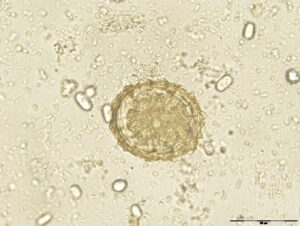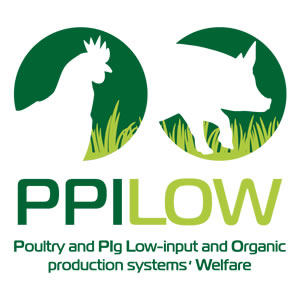PPILOW scientific publications
1: Intake of nutrients (polyunsaturated fatty acid, tocols, and carotenes) and storage efficiency in different slow-growing chicken genotypes reared in extensive systems – by Cesare Castellini (UNIPG)
Extensive rearing system (ERS) of poultry requires an outdoor run, which involves the foraging activity of chickens. Indeed, pasture is an essential aspect of ERS although it is clear that grass intake does not ensure sufficient energy and protein for bird growth. Many factors modulate the foraging activity of chickens: Slow-growing (SG) strains have a higher scavenger activity than fast-growing (FG) and generally they have higher level of bioactive compounds in the meat. The aim of the paper was to assess the storage efficiency of n-3 and n-6 polyunsaturated fatty acids (PUFA), tocols (all the vitamin E isoforms) and carotenes in the meat of seven commercial SG genotypes having different daily weight gains and walking activity. Chickens were reared in pens with indoor and outdoor areas and feed and grass intake was estimated. At 81 days of age, the breast, thigh and drumstick meat from 30 carcasses/genotype were analyzed. Nutrients (e.g., n-3, n-6, carotenes and tocols) of feed, grass and meat were analyzed and the storage efficiency was estimated as the ratio between the amount present in the muscles and the dietary intake (feed and grass). The genotype affected foraging behavior of chicken and the intake of nutrients. The intake of n-3 in genotypes with higher walking activity came mainly from grass (more than 50%), whereas in the other genotypes, less than 20%. Accordingly, chickens that foraged more showed better nutritional profiles of meat (less fat, more n-3 and antioxidants), which could be ascribed to grass ingestion. However, the storage efficiency of nutrients into meat was inversely correlated with the grass intake: strains with higher grass intake had lower storage rate. The result suggest that foraging is relevant for nutrient intake because it provides a high share of nutrients, i.e., carotenes, tocols and n-3 PUFA, which are often scarce in standard poultry feed. Accordingly, the more foraging chicken genotypes had better meat nutritional profiles (less fat, more n-3 PUFA and LC-PUFA content) than not-foraging ones, due to the intake of grass which is a free source of nutrients in ERS. However, the foraging behavior was negatively associated with the ability to store nutrients in body meat. Genetic selection should be used to favor chickens with a good balance between foraging and recovery rates of nutrients, given that more active animals have lower storage efficiencies.
Intake of nutrients (polyunsaturated fatty acids, tocols, and carotenes) and storage efficiency in different slow-growing chickens genotypes reared in extensive systems. Mattioli, S., Mancinelli, A. C., Dal Bosco, A., Ciarelli, C., Amato, M. G., Angelucci, E., Chiattelli, D., Castellini, C. (2022). Plos one, 17(11), 2022. https://doi.org/10.1371/journal.pone.0275527
2: Early-life interventions to prevent feather pecking and reduce fearfulness in laying hens – by Saskia Kliphuis (UU)
Severe feather pecking is a major welfare issue in laying hens. Possible underlying causes are fearfulness and lack of foraging opportunities. Because early life is a crucial stage in behavioral development, adapting the incubation and rearing environment to the birds’ needs may reduce fearfulness and prevent the development of feather pecking. In a 2*2 factorial design study, we investigated whether a green light-dark cycle throughout incubation, which resembles natural incubation circumstances more than the standard dark incubation, and foraging enrichment with live larvae during rearing reduce fearfulness and feather pecking and increase foraging behavior of laying hen pullets from an early age onwards. A slight increase in the number of foraging bouts was only seen with larvae provisioning. Neither lighted incubation nor larvae provisioning affected fearfulness, feather pecking, plumage condition or recovery time after vaccination. In conclusion, the present study showed no effects of light during incubation and minor effects of foraging enrichment during rearing on the behavior of laying hen pullets.
Early-life interventions to prevent feather pecking and reduce fearfulness in laying hens. Kliphuis, S., Manet, M. W., Goerlich, V. C., Nordquist, R. E., Vernooij, H., van den Brand, H., Tuyttens, F. A. M. & Rodenburg, T. B. (2023). Poultry Science. https://doi.org/10.1016/j.psj.2023.102801
3: The Effects of Allium sativum L., Artemisia absinthium L., Cucurbita pepo L., Coriandrum sativum L., Satureja hortensis L. and Calendula officinalis L. . on the Embryogenesis of Ascaris suum Eggs during an In Vitro Experimental Study – by Vasile Cozma (USAMV)
Ascaris suum L. is present in traditionally managed indoor pig herds and on industrialized farms, especially in older fatteners and sows. Increasing resistance against common anti-helminthic drugs redirected research towards alternative and traditional therapies that also include medicinal plants. This study comparatively evaluated the in vitro antiparasitic effects of Allium sativum L., Artemisia absinthium L., Cucurbita pepo L., Coriandrum sativum L., Satureja hortensis L. and Calendula officinalis L. against A. suum egg hatching and larval development. A. suum eggs were sampled from randomized faecal specimens collected from traditionally raised swine, in Romania. The egg suspension (ES, 8×103/ml) was divided into two control (C) (1C – 1ml ES + 1 ml distilled water, 2C- five plates of 1ml ES + 1ml ethanol of 70%, 35%, 17.5%, 8.75%, and 4.375%, respectively) and six experimental groups, and placed in 3 ml cell plates. The experimental (EG, 1-6) groups included ES + each alcoholic plant extract (10%, 5%, 2.5%, 1.25%, 0.625%). Both C and EG were performed in quintuplicate. All variants were incubated at 27℃ for a total of 21 days. A. suum eggs were examined after 2, 14 (L1), and 21 (L2/L3) days of incubation. The efficacy of all tested plants when compared to the control groups increased with concentration. Anti-embryogenic effects on A. suum eggs were expressed by all plants. A superior influence was observed in A. sativum, A. absinthium, C. pepo and S. hortensis extracts at all concentrations tested. A. sativum and A. absinthium extracts showed the strongest anti-helminthic activity, while C. sativum and C. officinalis were the weakest ascaricids. The chemical composition of the six Romanian medicinal plants used in the present study is similar to that reported in the specialized literature. The differences between the main biological compounds are given by their concentration. The findings of the present study will hopefully contribute to the field of plant anti-helminthic preparations to develop sustainable, effective and safe alternatives to conventional anti-helminthic drugs. The anti-helminthic activity exhibited by some alcoholic plant extracts against A. suum eggs in this study bears prominent importance considering the worldwide emergence of anthelmintic resistance. To our knowledge, this is the first ethno-pharmacological report based on the anthelmintic activity of medicinal plants traditionally used to treat A. suum infection in Romania. In the current study, all plants extracts showed various degrees of inhibitory effects on egg development. A. sativum, A. absinthium, C. pepo and S. hortensis extracts have shown the strongest anthelmintic activity. Based on the results of this study we suggested that some of these plant materials could be prospective sources for development of new anti-parasitic herbal remedies.



Ascaris suum unembryonated egg (400x) A. suum egg with L 2/3 (larva, 400x) Hatched L 2/3 (larva, 400x)
All pictures © USAMV
The effects of Allium sativum L., Artemisia absinthium L., Cucurbita pepo L., Coriandrum sativum L., Satureja hortensis L. and Calendula officinalis L. on the embryogenesis of Ascaris suum eggs during an in vitro experimental study. Mihai-Horia Bǎieş, Cǎlin Gherman , Zsolt Boros, Diana Olah, Ana-Maria Vlase, Anamaria Cozma-Petruţ, Adriana Györke, Doina Miere, Laurian Vlase, Gianina Crişan, Marina Spînu,Vasile Cozma, Pathogens 2022, 11(9),1065. http://dx.doi.org/10.3390/pathogens11091065

